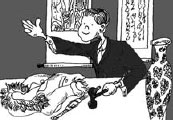'Shameful' exhibition backfires
By RAYMOND ZHOU (China Daily)Updated: 2007-02-03 07:32
 What do you call an auction where the sellers are hush-hush but the buyers
enter into a bidding spree?
What do you call an auction where the sellers are hush-hush but the buyers
enter into a bidding spree?
A marketer's dream, maybe. In the over-commercialized society that is today's China, businesses have to scream at the top of their voices to advertise themselves, but even that may not guarantee a significant turnout of customers.
A recent auction in Hefei, Anhui, attracted hundreds of buyers, who paid premiums as much as dozens of times over the listed prices of the items. The cash was meant for the cachet that the items carried with their previous ownership. They belonged to former governor Wang Huaizhong, former Fuyang mayor Xiao Zuoxin and five other deposed bureaucrats.
The officials were found guilty of corruption, and the items were seized as goods that they received as bribery. The filthy lucre was intended as a kind of "educational display" a deterrent for the potentially bad apples among public servants. But judging by the feedback, it had the opposite effect.
 A calligraphy couplet started at 50 yuan ($6), but was eventually sold for
3,200 yuan ($412). An imperial edict by Qianlong (1711-99) started at 100 yuan
($12), and ended up selling for 4,200 yuan ($520). Even a broken jade bracelet,
something that would be thrown out as garbage, was snapped up for 10 yuan (50 US
cents).
A calligraphy couplet started at 50 yuan ($6), but was eventually sold for
3,200 yuan ($412). An imperial edict by Qianlong (1711-99) started at 100 yuan
($12), and ended up selling for 4,200 yuan ($520). Even a broken jade bracelet,
something that would be thrown out as garbage, was snapped up for 10 yuan (50 US
cents).
According to reports, the buyers were collectors and businessmen.
The irony was that many of the businessmen said they were scouting for gifts for officials. "The holiday season is coming, and we have to do something to help our business dealings," said one.
In other words, the booty was being recycled - again used as inducement for official favors. What made them think that the 676 items of loot were great gift-giving ideas?
For one thing, they were less likely to be forgeries. Who would dare to give a fake Da Vinci, figuratively, for a license, an approval or an opportunity on which he stakes his future fortune? So, the quality of the arts, antiques and artifacts on offer was more secure.
There was also some value accumulated from the status of the previous owners. A painting may be worth 10,000 yuan ($1,200), but since Big Shot XYZ had it for a while, it now has a back story, an enriched history, so to speak. Now that some of the owners have been executed or are serving long prison sentences, that story has a layer of added drama and excitement, enhancing its curiosity value.
This reminds me of the "Red Mansion" in Fujian, the entertainment venue that uber-corrupter Lai Changxing used to seduce power players with beautiful wine and more beautiful women. The name took on such a mystique that some tourists would seek it out while traveling in Xiamen. If the local authorities had designated it as a tourist site, it could have generated revenues.
But people expecting an opulent palace were disappointed. The exterior of the building was subdued because the Great Smuggler did not want to attract attention.
In a sense, this landmark of extreme corruption is no different from the Forbidden City, where royal families did not really separate state assets from personal belongings. If Lai had harbored any artistic ambitions and hired an architectural genius for the design, his "mansion" may well have become a similar site of "historic interest".
However, the government's intention of turning this and other loot into symbols of disgrace obviously did not work. As it stands, people were not dissuaded. Rather, they gauged the price of taking bribes whether it is worth the risk to take, say, a 65,000-yuan Rolex.
The biggest irony, though, is the cruel fact that many of the items have indeed been found to be forgeries. In the tug of war between money and power, a bribe may well be a replay of The Necklace, the poignant story by Guy de Maupassant
(China Daily 02/03/2007 page4)
|
|
|
|